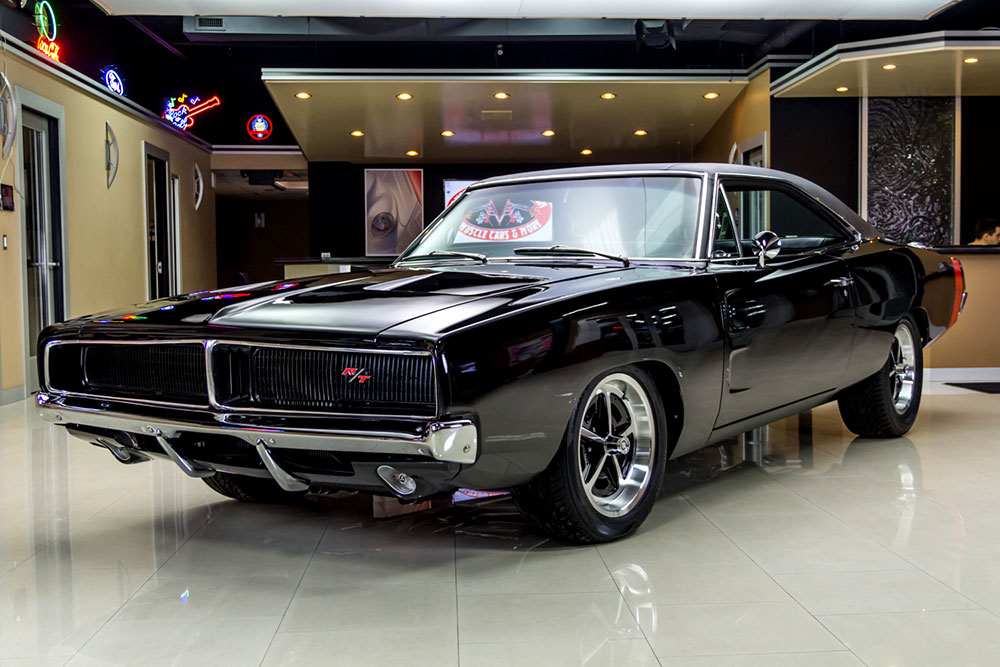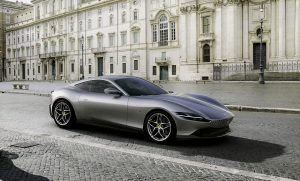The Dodge Charger was introduced on January 1, 1966. The Charger was further differentiated from the Dodge Coronet models using its own body but built off of the Coronet chassis.
Charger was Dodge’s first fastback, high-speed street racer. It featured many styling cues from the Charger II concept car like a fastback roof design and full width taillamps. The interior featured four bucket seats and a full-length floor console.

The vehicle came with a standard 5.2-liter, 318 cubic-inch V-8 engine delivering 230 horsepower. Other available engines included a 361 cubic-inch V-8 engine that created 265 horsepower, or a 6.2-liter, 383 cubic-inch V-8 engine delivering 325 horsepower. However, it was the availability of a massive 426 cubic-inch Street HEMI® engine that provided 425 horsepower and 490 lb.-ft. of torque that forever defined the vehicle.
In 1966 Dodge took the Charger into NASCAR in hopes that the fastback would make their car a winner on the high-banks. But the car proved to have rear end lift around corners which made it very slippery on the faster tracks.

The Dodge Charger was completely restyled In 1968, and now featured a big, bold, aggressive look. A new roof design, called a tunnel roof or a flying buttress. An exposed decorative gas filler cap also was a design feature. charger emblem In order to further boost the Charger’s muscle car image, a new high-performance package was added, the R/T. This stood for “Road and Track” and would be the high performance badge that would establish Dodge’s performance image. Only the high performance cars were allowed to use the R/T badge. The R/T came standard with the previous year’s 440 “Magnum”. The Slant Six was added to the option list in 1968, but it proved to be a very poor seller. Most people wanted a V8 in their Charger. The rest of the engine lineup (318-2, 383-2, 383-4, 426-8) remained unchanged.
The racing version of the new 1968 Charger combined aerodynamic design, and handling and performance for national circuit racing objectives. No other automaker had applied aerodynamic principles to a race car before, and because of wind tunnel testing, rear spoilers were introduced on NASCAR machines of the mid ’60s to control the tremendous amount of rear lift. In addition, the first front air dam was developed to counteract lifting in the front end.

In 1969. exterior changes included a new grill with a center divider and new longitudual taillights. A new trim line called the SE or Special Edition was added. This could be available by itself or packaged with the R/T thus making a R/T SE. The SE added leather inserts to the front seats only, chrome rocker mouldings, a wood grain sterring wheel and wood grain inserts on the instrument panel. A sunroof was added to the option list as well and it would prove to be a very rare option. The bumble stripes returned as well but were changed slightly. Instead of four stripes it now featured one huge stripe framed by two smaller stripes. In the middle of the stripe an R/T cutout was placed. If the stripe was deleted then a metal R/T emblem was placed where the R/T cutout was.
There were two different 383 motors available in ’69: 2-barrel and 4-barrel. The 2-barrel motor was rated at 290 hp. The four barrel motor was rated at 330 hp and was identified by the “pie tin” on the air cleaner as “383 / FOUR BARREL”. The 330-hp engine was unique to the Charger model in 1969. While this engine was available with an un-silenced air cleaner option, it differed internally from the 335-hp 383 “Magnum”. In 1969 the B-series engines were all painted turquoise with the exception of the 440 Magnum and 426 hemi which were painted Street Hemi Orange. The 335-hp 383 Magnum engines were also painted Street Hemi Orange. The 383 Magnum motor was used in Road Runners and Super Bee’s but did not appear in a Charger body until 1971. Differences between the 330-hp 383 4-barrel and 335-hp 383 magnum were mostly internal. Both versions used the Carter AVS carb and the larger exhaust manifolds from the 440 magnum engines, but the magnum had a windage tray in the oil pan. The cams shaft profiles were different as were the valve springs.

Total production dropped slightly to around 85,680 units. But in 1969 Dodge had its eye on NASCAR and in order to compete it would have to create two of the most rare and desirable of all Chargers: Charger 500, and the Charger Daytona.
The Dodge Charger had a great success movies also. It`s bad boy looks and rebel reputation made it wanted by a lot of directors and film producers.
It`s first important role was in the movie Bullit were it was diriven by the bad guys. The chase featuring Steve McQueen driving a Ford Mustang and the bad guys in a Dodge Charger was one of the best car chases ever made. But unfortunately for the Charger, it ended badly.
The modern day “rebirth” of the legend was in the first part of the Fast and Furious film, where a 1970 supped up Charger was presented as the ultimate car. With 900 Hp, the car was a monster on wheels and Dominic (Vin DIesel) was terrified but that car. Of course, in the purest Hollywood style, the car was completly destroied at the end.

In 2005 another legendary Charger was brought to life: General Lee , the car that the two brothers, The Dukes of Hazard drove in 1969 Charger. “The General” had the Confederate flag painted on the roof and the words “GENERAL LEE” over each door. The windows were always open, as the doors were (allegedly) welded shut. The number “01” is painted on both doors. Also, when the horn is pressed, it plays the first 12 notes from the de facto Confederate States anthem “Dixie”. The muscle car performed spectacular jumps in almost every episode, and the show’s popularity drove a surging interest in the car. The show itself purchased hundreds of Chargers for stunts, as they generally destroyed at least one car per episode. (Real Chargers stopped being used for jumps at the end of the show’s sixth season, and were grudgingly replaced with miniatures.)
Other movies that featured the Charger: Speedway (1968),Dirty Mary, Crazy Larry (1974), Truck Turner (1974), Cannonball (1976), Bad Georgia Road (1977), Christine (1983), The Philadelphia Experiment (1984), Blue Velvet (1986), Forever Young (1992), Unlawful Entry (1992), The Vampire in Brooklyn (1995), Spy Hard (1996), Vanishing Point Remake (1997), Blade (1998), ED TV (1999), Best Laid Plans (1999), Payback (1999), The Forsaken (2001), The Mexican (2001), Blade II (2002), Big Fish (2003), Blade: Trinity (2004), Man on Fire (2004), Dukes of Hazzard (2005), House of Wax (2005), Banshee (2006)
General characteristics
Engine:
225 cu in (3.7 L) 1bbl I6 (1969-70)
318 cu in (5.2 L) 2bbl LA V8
383 cu in (6.3 L) 2bbl B V8
383 cu in (6.3 L) 4bbl B V8
426 cu in (7.0 L) Hemi 2×4bbl RB V8
440 cu in (7.2 L) 4bbl RB V8
440 cu in (7.2 L) 2×3 RB (1970)
Transmission:
A904 3-speed automatic
A727 3-speed automatic
A230 3-speed manual
A833 4-speed manual
Wheelbase:
117 in (3,000 mm)
Length:
208 in (5,300 mm) (1968)
207.9 in (5,280 mm) (1969-70)
Width:
76.7 in (1,950 mm) (1968-69)
76.6 in (1,950 mm) (1970)
Height:
53.2 in (1,350 mm) (1968-69))
53.0 in (1,350 mm) (1970)
Share this:
- Click to share on Facebook (Opens in new window)
- Click to share on Twitter (Opens in new window)
- Click to print (Opens in new window)
- Click to share on LinkedIn (Opens in new window)
- Click to share on Reddit (Opens in new window)
- Click to share on Tumblr (Opens in new window)
- Click to share on Pinterest (Opens in new window)
- Click to share on Pocket (Opens in new window)
- Click to share on Telegram (Opens in new window)
- Click to share on WhatsApp (Opens in new window)





Pingback: Dodge Charger 1525bhp SpeedKore | Welcome to the 007 World!
Pingback: 635-HP Dodge Charger Daytona | Welcome to the 007 World!